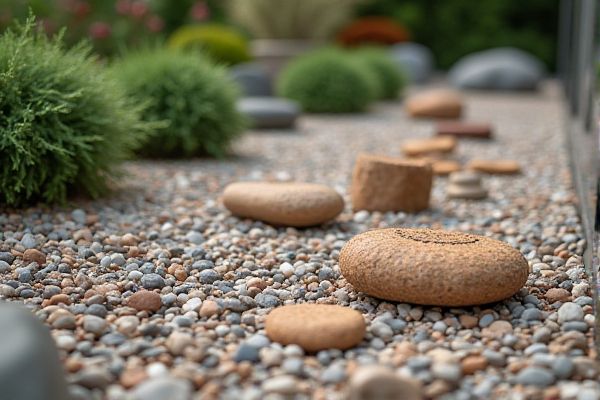
Decorative gravel enhances the visual appeal of your landscaping with attractive colors and textures, while functional gravel serves practical purposes like drainage, erosion control, and pathway stability. Discover how to choose the right type of gravel for your outdoor projects by reading the rest of this article.
Table of Comparison
| Feature | Decorative Gravel | Functional Gravel |
|---|---|---|
| Purpose | Enhances visual appeal in landscaping and garden design | Provides drainage, drainage layering, and structural support |
| Size and Shape | Uniform, smooth, and polished stones for aesthetics | Varied sizes, often angular for better compaction |
| Material | Quartz, river rock, marble chips, or colored stones | Crushed stone, limestone, granite for durability |
| Color | Available in multiple colors to match design themes | Usually neutral tones like gray, brown, or white |
| Usage | Pathways, gardens, decorative borders, mulching | Drainage layers, road base, concrete aggregate, erosion control |
| Cost | Higher due to aesthetic quality and processing | Lower, focused on functionality and availability |
| Durability | Moderate; depends on stone type and weather exposure | High; designed to withstand pressure and environmental conditions |
Understanding Decorative Gravel: Aesthetic Appeal
Decorative gravel enhances landscaping with vibrant colors, varied sizes, and smooth textures that create visually appealing garden beds, pathways, and patios. Its primary purpose is to elevate outdoor aesthetics by complementing plantings and architectural features while requiring minimal maintenance. Unlike functional gravel, decorative gravel focuses on design impact rather than structural or drainage roles.
Functional Gravel: Purpose and Utility
Functional gravel serves essential purposes such as drainage, erosion control, and foundational support in construction projects, ensuring structural stability and preventing water accumulation. It is typically chosen for its durability, size, and composition to meet specific engineering requirements, enhancing the longevity and safety of infrastructures. Your selection of functional gravel directly impacts the effectiveness of water filtration systems, roadbeds, and landscape grading.
Key Differences Between Decorative and Functional Gravel
Decorative gravel enhances landscape aesthetics with smooth textures and vibrant colors, making it ideal for pathways, garden beds, and patios. Functional gravel prioritizes drainage and stability, using angular, coarse materials that prevent erosion and stabilize surfaces like driveways and construction bases. Your choice depends on whether visual appeal or utility is the primary goal in your outdoor project.
Popular Types of Decorative Gravel
Popular types of decorative gravel include pea gravel, known for its smooth, colorful stones ideal for garden paths and patios; crushed granite, prized for its angular shape and durability, making it suitable for driveways and walkways; and river rock, valued for its rounded, polished appearance that enhances landscaping aesthetics. Each type serves a specific design purpose, offering both visual appeal and practical benefits depending on the landscaping project. Your choice of decorative gravel depends on the desired texture, color, and overall effect you want to achieve in your outdoor space.
Common Uses of Functional Gravel in Landscaping
Functional gravel is primarily used in landscaping for drainage systems, driveways, and pathways due to its ability to facilitate water runoff and provide a stable base. It often serves as a foundational layer beneath patios, walkways, and retaining walls to prevent soil erosion and improve structural integrity. This type of gravel is chosen for its durability and practical benefits rather than aesthetic appeal.
Cost Comparison: Decorative vs Functional Gravel
Decorative gravel typically costs more than functional gravel due to its aesthetic grading, color options, and uniform size, averaging between $50 to $150 per ton compared to $20 to $60 per ton for functional gravel. Functional gravel, often used for drainage and construction base layers, prioritizes durability and percolation over appearance, making it more budget-friendly for large-scale projects. The choice between decorative and functional gravel impacts overall project costs, where decorative gravel increases expenses with its premium look, while functional gravel serves utilitarian purposes at a lower price point.
Maintenance Requirements for Each Gravel Type
Decorative gravel requires regular cleaning and occasional replenishing to maintain its aesthetic appeal, often needing weed control measures such as landscape fabric or herbicides. Functional gravel, used for drainage or structural purposes, demands less frequent maintenance but should be checked periodically for clogging or displacement to ensure proper functionality. Both types benefit from periodic raking to prevent compaction and maintain their intended performance.
Installation Techniques: Decorative Versus Functional Gravel
Decorative gravel installation emphasizes even spreading and precise layering to achieve aesthetic appeal, often incorporating edging materials to maintain clean boundaries. Functional gravel installation requires compaction and grading techniques to ensure durability, proper drainage, and load-bearing capacity for pathways or driveways. Both types benefit from a well-prepared base, but functional gravel typically demands more rigorous sub-base preparation to withstand heavy use.
Environmental Impact: Choosing the Right Gravel
Decorative gravel often comes from quarried stone, which can involve significant land disruption and carbon emissions during extraction and transportation. Functional gravel, such as crushed stone used for drainage or road base, typically prioritizes durability and permeability, reducing environmental impact by supporting natural water filtration and minimizing runoff. Selecting gravel based on environmental impact requires assessing local sourcing practices, gravel composition, and intended use to balance ecological footprint with functionality.
Which Gravel is Right for Your Project?
Decorative gravel enhances the visual appeal of landscapes with smooth, colorful stones ideal for pathways, garden beds, and patios, while functional gravel provides essential drainage and structural support in driveways, foundations, and drainage systems. Your project's requirements for aesthetics versus performance will determine the best choice, ensuring durability and design harmony. Assess factors like gravel size, texture, and drainage needs to select the optimal gravel type tailored to your specific outdoor space.
 homyna.com
homyna.com